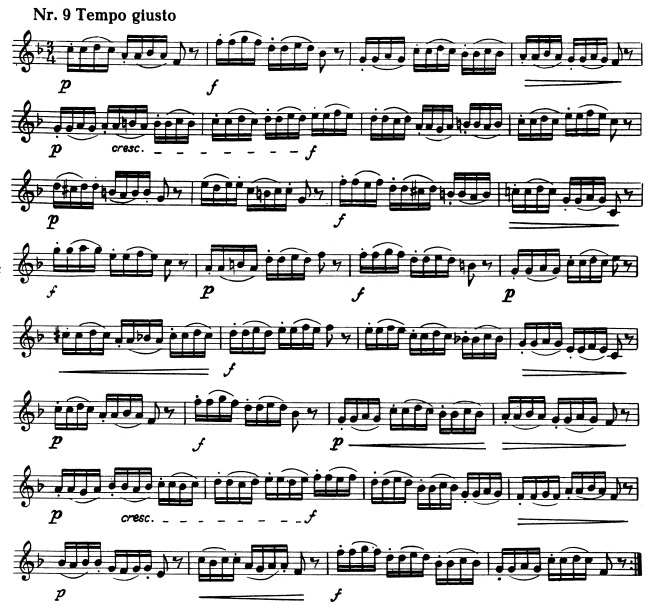Music
As I’ve mentioned in all my other Kopprasch etude walkthroughs, you can either get a free version of the Kopprasch etudes from IMSLP, or you can spring for a slightly nicer and better edited version. Either way, these are etudes that you should get. They cover a lot of the basics of horn playing and they are often used for All-State audition music. Here is the IMSLP version of #9:

Key Points:
- The primary challenge of this etude is tongue-one-slur-three articulation (although it’s really tongue-two-slur-two, but more on that later). The air must move quickly to both energize the tongue stroke and be coordinated with the fingers for the slur up or down by a step. Also, while the slur is at the end of the 16th note groups most of the time – it isn’t always. Make sure you pay attention when the pattern changes!
- Like a lot of Kopprasch studies, if you know just a few difference scales and their arpeggios, the pattern of notes becomes easily predictable.
- While there are a few dynamic shadings in many editions of this etude, be aware of the two primary dynamics – forte and piano.
Technical Tips:
- Articulation – a quick and light articulation is required for the two tongued 16th notes. If you have to slow down the tempo for the tongued notes, the etude will lose a lot of its lively character, and it will become much more challenging from an endurance standpoint. Remember to blow through the tongued notes – practice this away from the horn and mouthpiece.
- Slurs – even though this exercise looks like the articulation pattern is tongue-one-slur-three, it’s actually slur-two-tongue-two. Remember that the slur only effects the endings of two notes (the first two under the slur) and the beginning of two notes (the last two under the slur). This means that the first note of the slur still needs a crisp articulation, and the final note of the slur can be a little bit shorter (especially at a slower tempo) to ensure a firm “TA” articulation on the following tongued note.
- Scales – I’ve touched on this a lot in my other Kopprasch walkthroughs, but it should go without saying that you know your scales!
- Dynamics – when you have the large dynamics changes (for example, from bar 1 to bar 2) remember that dynamic changes are mostly a result of air intensity changes (for example, sighing (low intensity, quiet dynamic) vs. blowing out candles (high intensity, louder dynamic)). Register changes are mostly a result of air speed changes (for example blowing hot air on your hand (low notes) vs. cold air (higher notes)). Practicing this away from the horn can be very useful.

